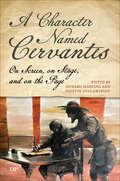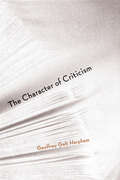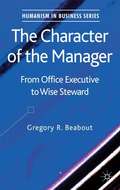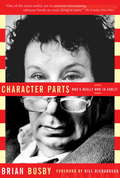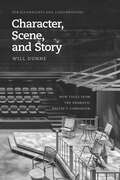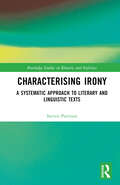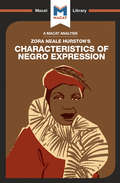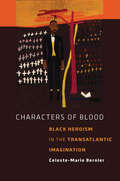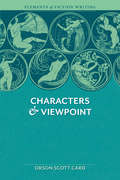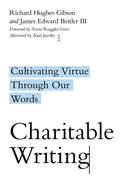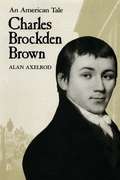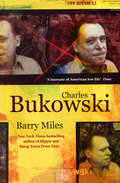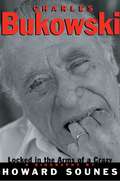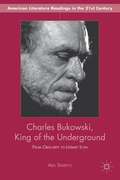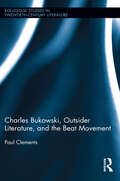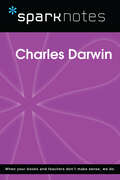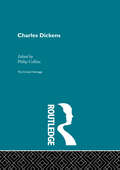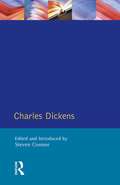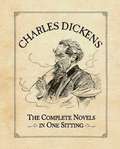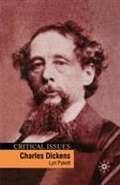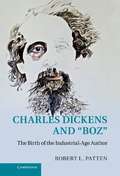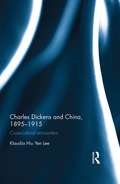- Table View
- List View
A Character Named Cervantes: On Screen, on Stage, and on the Page (Toronto Iberic #95)
by Howard Mancing Tatevik GyulamiryanMiguel de Cervantes, writer of Don Quixote, has frequently been portrayed in fictionalized contexts across various mediums. In A Character Named Cervantes, Howard Mancing and Tatevik Gyulamiryan explore how Cervantes’s life is depicted in biographies and fiction and how he, as a (bio)fictional character, contributes to our understanding of reality and fiction, fact and invention, history and imagination, and above all, our perceptions of these concepts.The book reveals that Cervantes’s life was unlike anyone else’s. Characterized by an array of extraordinary experiences – both triumphant and tumultuous, adventurous and misfortunate, impassioned and disillusioned – his life events mirror the quixotic spirit he famously imbued in his iconic character. Despite the wealth of documented events, a lot about Cervantes remains uncovered, which allows for human imagination, interpretation, and creation to intervene, attempting to provide a more comprehensive biography. The book highlights how Cervantes’s life has inspired multiple interpretations and recreations by historians, biographers, and novelists alike. It emphasizes the crucial role of human imagination in the crafting of biographies, particularly within literary and scholarly traditions. Ultimately, A Character Named Cervantes examines Cervantes through the dual lenses of fiction and fictionalized history.
The Character of Criticism
by Geoffrey Galt HarphamFirst published in 2007. Routledge is an imprint of Taylor & Francis, an informa company.
The Character of the Manager
by Gregory R. BeaboutExplores Alasdair MacIntyre's criticisms of the manager and retrieves an interdisciplinary approach to character transforming arguments. The manager as wise steward is proposed as a model for virtuous management.
Character Parts
by Brian BusbyEver wondered where novelists get the inspiration for their characters? Why the hero or villain of your favourite book seems oddly familiar? Who inspired Mordecai Richler to create Bernard Gursky; Margaret Atwood to create Zenia in The Robber Bride? In which novel does Northrop Frye appear (as a character named Morton Hyland)? The answers can be found in Character Parts, Brian Busby's irreverent yet authoritative guide to who's really who in Canadian literature. The most original and entertaining reference book to be published in years, Character Parts is the behind-the-scenes look at CanLit we have all been waiting for.Brian Busby settles the suspicions that arise when a fictional character reminds you of a real-life one, listing the sources for characters from the whole of Canadian literature. His canvas stretches from the settlers who inspired 1852's Roughing It in the Bush to Glenn Gould's appearance as Nathaniel Orlando Gow in Tim Wynne-Jones' The Maestro, and beyond. But Character Parts is also chock-full of fascinating, less famous people who have been immortalized in Canadian books: seductive Alberta politicians, British army generals, anarchists, models, aristocrats -- and, of course, parents, siblings and ex-spouses.Authoritative, but presented with a light touch, Character Parts is as at home in a university library as on a bathroom shelf. It's that rare find: an exemplary reference book that is also an absolutely entertaining read in its own right.From the Hardcover edition.
Character, Scene, and Story: New Tools from the Dramatic Writer's Companion (Chicago Guides to Writing, Editing, and Publishing)
by Will DunneWill Dunne first brought the workshop experience down to the desk level with The Dramatic Writer’s Companion, offering practical exercises to help playwrights and screenwriters work through the problems that arise in developing their scripts. Now writers looking to further enhance their storytelling process can turn to Character, Scene, and Story. Featuring forty-two new workshop-tested exercises, this sequel to The Dramatic Writer’s Companion allows writers to dig deeper into their scripts by fleshing out images, exploring characters from an emotional perspective, tapping the power of color and sense memory to trigger ideas, and trying other visceral techniques. The guide also includes a troubleshooting section to help tackle problem scenes. Writers with scripts already in progress will find they can think deeper about their characters and stories. And those who are just beginning to write will find the guidance they need to discover their best starting point. The guide is filled with hundreds of examples, many of which have been developed as both plays and films. Character, Scene, and Story is fully aligned with the new edition of The Dramatic Writer’s Companion, with cross-references between related exercises so that writers have the option to explore a given topic in more depth. While both guides can stand alone, together they give writers more than one hundred tools to develop more vivid characters and craft stronger scripts.
Characterising Irony: A Systematic Approach to Literary and Linguistic Texts (Routledge Studies in Rhetoric and Stylistics)
by Steven PattisonThis book offers a systematic, bottom-up account of irony across both everyday contexts and literary and linguistic texts, using an empirically rigorous approach in distinguishing between central irony, non-central ironies, and non-ironies and highlighting a new way forward for irony research. The volume considers the current landscape of irony, in which the term is used with increasing frequency with the knock-on effect of a loosening of its meaning. Pattison addresses this challenge by applying a systematic form of analysis, rooted in frameworks from pragmatics and complementary disciplines, to a database of over 500 irony candidates from a wide range of sources. The book uses these examples to illustrate the features of central ironies as well as the attributes used to differentiate between central ironies, non-central ironies, and non-ironies. These attributes are mapped across four key domains, including: difference and opposition; the role of context; how ironies are signaled; and speaker attitude and intention. Taken together, the volume puts forth a credible account for more clearly characterizing examples of irony and equips researchers with a comprehensive step-by-step method for undertaking future research. This book is key reading for scholars in stylistics, pragmatics, literary studies, and psycholinguistics.
Characteristics of Negro Expression
by Benjamin Lempert Mercedes AguirreThe racial prejudices of 1930s America were many, and included a common presumption that African American art was unoriginal – merely poorly copying white culture. African-American novelist, anthropologist and essayist Zora Neale Hurston crushingly evaluated such assumptions in her 1934 essay ‘Characteristics of Negro Expression.’ While Hurston’s approach and premises seem in many ways dated to modern readers, the essay still shows an incisive mind carefully evaluating arguments and cutting them down to size. African-American art of the time did not – Hurston influentially argued – play by the same rules as white art, so it could not meaningfully be discussed by ‘white’ notions of aesthetic value. Where white European tradition views art as something fixed, Hurston saw African-American art works as a distinctive form of mimicry, reshaping and altering the original object until it became something new and novel. In this way, she contended, African-American creative expression is a process that generates its own form of originality – turning borrowed material into something original and unique. By carefully evaluating the relevance of previous arguments, Hurston showed African American artistic expression in an entirely new light.
Characters of Blood: Black Heroism in the Transatlantic Imagination
by Celeste-Marie BernierAcross the centuries, the acts and arts of black heroism have inspired a provocative, experimental, and self-reflexive intellectual, political, and aesthetic tradition. In Characters of Blood, Celeste-Marie Bernier illuminates the ways in which six iconic men and women—Toussaint Louverture, Nathaniel Turner, Sengbe Pieh, Sojourner Truth, Frederick Douglass, and Harriet Tubman—challenged the dominant conceptualizations of their histories and played a key role in the construction of an alternative visual and textual archive.While these figures have survived as symbolic touchstones, Bernier contends that scholars have yet to do justice to their complex bodies of work or their multifaceted lives. Adopting a comparative and transatlantic approach to her subjects’ remarkable life stories, the author analyzes a wealth of creative work—from literature, drama, and art to public monuments, religious tracts, and historical narratives—to show how it represents enslaved heroism throughout the United States, Africa, and the Caribbean. In mapping this black diasporic tradition of resistance, Bernier intends not only to reveal the limitations and distortions on record but also to complicate the definitions of black heroism that have been restricted by ideological boundaries between heroic and anti-heroic sites and sights of struggle.
Characters & Viewpoint: Proven advice and timeless techniques for creating compelling characters by an a ward-winning author (Elements Of Fiction Writing Ser.)
by Orson Scott CardCard, an award winning science fiction novelist, offers a how-to manual for creating characters in one's own fiction. The text is separated into three parts, inventing characters, constructing characters, and performing characters which are further divided into more specific chapters. Card uses short example paragraphs throughout to explain techniques such as creating a comic character or unreliable narrator. A handful of illustrations show the different points of view. The budding fiction writer will find this text a useful jumping-off point for creating believable characters. Annotation ©2011 Book News, Inc. , Portland, OR (booknews. com)
Charitable Writing: Cultivating Virtue Through Our Words
by James Edward Beitler III Richard Hughes GibsonOur written words carry weight. Unfortunately, in today's cultural climate, our writing is too often laced with harsh judgments and vitriol rather than careful consideration and generosity. But might the Christian faith transform how we approach the task of writing? How might we love God and our neighbors through our writing? This book is not a style guide that teaches you where to place the comma and how to cite your sources (as important as those things are). Rather, it offers a vision for expressing one's faith through writing and for understanding writing itself as a spiritual practice that cultivates virtue. Under the guidance of two experienced Christian writers who draw on authors and artists throughout the church's history, we learn how we might embrace writing as an act of discipleship for today—and how we might faithfully bear the weight of our written words.
Charles Austin Beard: The Return of the Master Historian of American Imperialism
by Richard DrakeRichard Drake presents a new interpretation of Charles Austin Beard's life and work. The foremost American historian and a leading public intellectual in the first half of the twentieth century, Beard participated actively in the debates about American politics and foreign policy surrounding the two world wars. Drake takes this famous man's life and rewrites his intellectual biography by placing the European dimension of Beard's thought at the center. This radical change of critical focus allows Drake to correct previous biographers' oversights and, in Charles Austin Beard, present a far more nuanced appreciation for Beard's life than we have read before.Drake proposes a restoration of Beard's professional reputation, which he lost in large part because of his extremely unpopular opposition to America's intervention in World War II. Drake analyzes the stages of Beard's development as a historian and critic: his role as an intellectual leader in the Progressive movement, the support that he gave to the cause of American intervention in World War I, and his subsequent revisionist repudiation of Wilsonian ideals and embrace of non-interventionism in the lead-up to World War II. Many of his dire predictions about the inevitable consequences of pre-World War II American foreign policy have come to pass. Drake shows that, as Americans tally the ruinous costs—both financial and moral—of nation-building and informal empire, the life and work of this prophet of history merit a thorough reexamination.
Charles Brockden Brown: An American Tale
by Alan AxelrodCharles Brockden Brown: An American Tale is the first comprehensive literary, biographical, and cultural study of the novelist whom critic Leslie Fiedler has dubbed "the inventor of the American writer. " The author of Wieland, Arthur Mervyn, Ormond, and Edgar Huntly, Charles Brockden Brown (1771-1810) is considered the first American professional author. He introduced Indian characters into American fiction. His keen interest in character delineation and abnormal psychology anticipates the stories of Poe, Hawthorne, and later masters of the psychological novel. Brown was eager to establish for himself an American identity as a writer, to become what Crèvecoeur called "the new man in the New World. " It is especially this intimate identification of writer with country that makes Brown a telling precursor of our most characteristic authors from Poe, Hawthorne, and Cooper to Fitzgerald, Hemingway, and Faulkner. To understand its significance, Brown's work must be examined as both art and artifact. Accordingly, Charles Brockden Brown: An American Tale is literary history as well as criticism, embued with insights into a writer's sources and influences and the psychology of literary composition. It is also a fascinating examination of a nation's emotional and intellectual impact on a young man in search of his identity as creative artist. Charles Brockden Brown: An American Tale is the first comprehensive literary, biographical, and cultural study of the novelist whom critic Leslie Fiedler has dubbed "the inventor of the American writer. " The author of Wieland, Arthur Mervyn, Ormond, and Edgar Huntly, Charles Brockden Brown (1771-1810) is considered the first American professional author. He introduced Indian characters into American fiction. His keen interest in character delineation and abnormal psychology anticipates the stories of Poe, Hawthorne, and later masters of the psychological novel. Brown was eager to establish for himself an American identity as a writer, to become what Crèvecoeur called "the new man in the New World. " It is especially this intimate identification of writer with country that makes Brown a telling precursor of our most characteristic authors from Poe, Hawthorne, and Cooper to Fitzgerald, Hemingway, and Faulkner. To understand its significance, Brown's work must be examined as both art and artifact. Accordingly, Charles Brockden Brown: An American Tale is literary history as well as criticism, embued with insights into a writer's sources and influences and the psychology of literary composition. It is also a fascinating examination of a nation's emotional and intellectual impact on a young man in search of his identity as creative artist.
Charles Bukowski
by Barry Miles'Fear makes me a writer, fear and a lack of confidence'Charles Bukowski chronicled the seedy underside of the city in which he spent most of his life, Los Angeles. His heroes were the panhandlers and hustlers, the drunks and the hookers, his beat the racetracks and strip joints and his inspiration a series of dead-end jobs in warehouses, offices and factories. It was in the evenings that he would put on a classical record, open a beer and begin to type...Brought up by a violent father, Bukowski suffered childhood beatings before developing horrific acne and withdrawing into a moody adolescence. Much of his young life epitomised the style of the Beat generation - riding Greyhound buses, bumming around and drinking himself into a stupor. During his lifetime he published more than forty-five books of poetry and prose, including the novels Post Office, Factotum, Women and Pulp. His novels sold millions of copies worldwide in dozens of languages.In this definitive biography Barry Miles, celebrated author of Jack Kerouac: King of the Beats, turns his attention to the exploits of this hard-drinking, belligerent wild man of literature.
Charles Bukowski: The Biography
by Howard SounesThe author known for his graphic and gritty autobiographic novels and whose life inspired the film "Barfly" is profiled in a biography that draws on new interviews with his family and friends, his private letters and unpublished writings, and commentary from Norman Mailer, Allen Ginsberg, Sean Penn, and others.
Charles Bukowski, King Of The Underground
by Abel DebrittoThis critical study of the literary magazines, underground newspapers, and small press publications that had an impact on Charles Bukowski's early career, draws on archives, privately held unpublished Bukowski work, and interviews to shed new light on the ways in which Bukowski became an icon in the alternative literary scene in the 1960s.
Charles Bukowski, Outsider Literature, and the Beat Movement (Routledge Studies in Twentieth-Century Literature)
by Paul ClementsThis book uses cultural and psycho-social analysis to examine the beat writer Charles Bukowski and his literature, focusing on representations of the anti-hero rebel and outsider. Clements considers the complexities, ambiguities, and contradictions represented by the author and his work, exploring Bukowski’s visceral writing of the cultural ordinary and everyday self-narrative. The study considers Bukowski’s apolitical, gendered, and working-class stance to understand how the writer represents reality and is represented with regards to counter-cultural literature. In addition, Clements provides a broader socio-cultural focus that evaluates counterculture in relation to the American beat movement and mythology, highlighting the male cool anti-hero. The cultural practices and discourses utilized to situate Bukowski include the individual and society, outsiderdom, cult celebrity, fan embodiment, and disneyfication, providing a greater understanding of the beat generation and counterculture literature.
Charles Bukowski, Outsider Literature, and the Beat Movement (Routledge Studies in Twentieth-Century Literature)
by Paul ClementsThis book uses cultural and psycho-social analysis to examine the beat writer Charles Bukowski and his literature, focusing on representations of the anti-hero rebel and outsider. Clements considers the complexities, ambiguities, and contradictions represented by the author and his work, exploring Bukowski’s visceral writing of the cultural ordinary and everyday self-narrative. The study considers Bukowski’s apolitical, gendered, and working-class stance to understand how the writer represents reality and is represented with regards to counter-cultural literature. In addition, Clements provides a broader socio-cultural focus that evaluates counterculture in relation to the American beat movement and mythology, highlighting the male cool anti-hero. The cultural practices and discourses utilized to situate Bukowski include the individual and society, outsiderdom, cult celebrity, fan embodiment, and disneyfication, providing a greater understanding of the beat generation and counterculture literature.
Charles Darwin (SparkNotes Biography Guide)
by SparkNotesCharles Darwin (SparkNotes Biography Guide) Making the reading experience fun! SparkNotes Biography Guides examine the lives of historical luminaries, from Alexander the Great to Virginia Woolf. Each biography guide includes:An examination of the historical context in which the person lived A summary of the person&’s life and achievements A glossary of important terms, people, and events An in-depth look at the key epochs in the person&’s career Study questions and essay topics A review test Suggestions for further reading Whether you&’re a student of history or just a student cramming for a history exam, SparkNotes Biography guides are a reliable, thorough, and readable resource.
Charles Dickens: The Critical Heritage (Critical Heritage Ser.)
by Philip CollinsThe Critical Heritage gathers together a large body of critical sources on major figures in literature. Each volume presents contemporary responses to a writer's work, enabling students and researchers to read for themselves, for example, comments on early performances of Shakespeare's plays, or reactions to the first publication of Jane Austen's novels.The carefully selected sources range from landmark essays in the history of criticism to journalism and contemporary opinion, and little published documentary material such as letters and diaries. Significant pieces of criticism from later periods are also included, in order to demonstrate the fluctuations in an author's reputation.Each volume contains an introduction to the writer's published works, a selected bibliography, and an index of works, authors and subjects.The Collected Critical Heritage set will be available as a set of 68 volumes and the series will also be available in mini sets selected by period (in slipcase boxes) and as individual volumes.
Charles Dickens (Longman Critical Readers)
by Steven ConnorDickens is second only to Shakespeare in the range and intensity of critical discussion which his work has provoked. His writing is central to literature and culture across the English-speaking world. In this important new anthology, Steven Connor gathers together representative examples of the range of new critical approaches to Dickens over the last two decades.
Charles Dickens: The Complete Novels in One Sitting (RP Minis)
by Joelle HerrCelebrate the bicentennial birthday of Charles Dickens with this Miniature Edition packed with witty summaries of the novels of one of history's most beloved storytellers. All fans of great literature can enjoy these perfectly portable renditions of "Oliver Twist, A Christmas Carol, Great Expectations, A Tale of Two Cities," and all the Dickensian classics. Featuring synopses, character profiles, and illustrations, this mini book brings to life twenty classic tales and the iconic characters that populate the world of Dickens.
Charles Dickens: Critical Issues (Critical Issues Ser.)
by Lyn PykettTo many of his contemporaries, Charles Dickens was the greatest writer of his age; a one-man fiction industry who produced fourteen massive novels, and numerous sketches, essays and stories, many of which appeared in the two magazines which he founded and edited. Today the work of one of the first and most successful mass-circulation authors continues to enthrall readers around the world. This wide-ranging book examines the writings of Dickens, not only in his time but also in ours. it looks at the author as a Victorian 'man of letters', and explores his cultural and critical impact both on the definition of the novel in the nineteenth century and the subsequent development of the form in the twentieth. Lyn Pykett focuses on Dickens as journalist, literary entrepreneur, the conductor of magazines, the shaper of the serial novel, the manipulator of the multiple plot, and the creator of eccentric characters. She also assesses the modernity of the writer's alienated protagonists and their social environments, as well as reassessing his representations of the vivid, bleak and at times menacing spectacle of the metropolis, from the late modern/postmodern perspective of the twenty first century. Each chapter of this text analyses the work of a particular decade in Dickens's career, providing a lively contextual study which places his writings in relation to the worlds that made him, and the literary worlds which he made. It is essential reading for all those with an interest in one of the most popular, and enduring, British novelists of all time.
Charles Dickens and 'Boz'
by Robert L. PattenDickens' rise to fame and his world-wide popularity were by no means inevitable. He started out with no clear career in mind, drifting in and out of the theatre, journalism and editing before finding unexpected success as a creative writer. Taking account of everything known about Dickens's apprentice years, Robert L. Patten narrates the fierce struggle Dickens then had to create an alter ego, Boz, and later to contain and extinguish him. His revision of Dickens' biography in the context of early Victorian social and political history and print culture opens up a more unstable, yet more fascinating, portrait of Dickens. The book tells the story of how Dickens created an authorial persona that highlighted certain attributes and concealed others about his life, talent and publications. This complicated narrative of struggle, determination, dead ends and new beginnings is as gripping as one of Dickens' own novels.
Charles Dickens and China, 1895-1915: Cross-Cultural Encounters
by Klaudia Hiu LeeFrom 1895 to 1915, Chinese translations of Dickens's fiction first appeared as part of a growing interest in Western literature and culture among Chinese intellectuals. Klaudia Hiu Yen investigates the multifarious ways in which Dickens’s works were adapted, reconfigured, and transformed for the Chinese readership against the turbulent political and social conditions in the last stages of the Qing dynasty (1644-1912) and the early Republic (1912-1949). Moving beyond the 'Response to the West’ model which often characterises East-West interactions, Lee explores how Chinese intellectuals viewed Dickens’s novels as performing a particular social function; on occasion, they were used to advance the country’s social and political causes. Translation and adaptation became a means through which the politics and social values of the original Dickens texts were undermined or even subverted. Situating the early introduction of Dickens to China within the broader field of Victorian studies, Lee challenges some of the theoretical and conceptual underpinnings of the ’global’ turn, both in Dickens scholarship and in Victorian studies in general.
